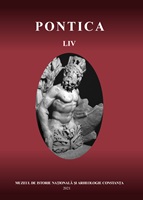Cercetări de suprafață în zona Bucșanilor (jud. Giurgiu). Completări ale unui repertoriu regional
Surface Surveys in Bucșani Area (Giurgiu County). Completing a Regional Repertory
Author(s): Cătălin Bem, Tudor Hila, Cătălin I. NicolaeSubject(s): Archaeology, Historical Geography, Prehistory
Published by: Muzeul de Istorie Națională și Arheologie Constanța
Keywords: Bucșani Microzone; density; Gumelnița; Bronze Age; the 2- nd to 3- rd centuries; isolated inn;
Summary/Abstract: Without being in any particular way exceptional, the Bucșani area of the Giurgiu County underwent much more surveys than many other similar areas. Continued up to the present, the research circumscribed to the initial space led to the discovery of numerous archaeological stations (Fig. 3), some still unpublished. In our contribution we focused upon the springs and upon a part of the upper course of the Ilfovăț River (Fig. 2), a left-hand tributary of the Neajlov River. The large dimensions of the surfaces on which we discovered archaeological materials forced us to handle the research in a more specific way. We started by making a virtual grid with cells measuring 10x10 m, with temporary markings in the field made with a GPS unit, the grid being over imposed and surpassing the previously known space from the dimensions of the surface and from the diffusion of the archaeological material point of view. As we went along with recording the density of the archaeological material, the temporary points were dismantled by shifting. In order not to overfill the map that represents the pottery fragment distribution, we opted for only five types of associations. Two of them refer to the presence of building material (brick or daub), the other three, to the relative number of pottery fragments. Our action led to the discovery and specific treatment of six new archaeological stations, includind a possible tell, one of them – at least on the basis of the distribution of archaeological material on the soil’s surface – being of huge dimensions, measuring 103.5 ha. One of the sites probably includes the remains of the Foișoru` Lipoviencii inn, cartographically recorded since the 18th century, the place name being partially conserved in the present day. It is not improbable that this site was included on the route of Tudor Vladimirescu’s march to Bucharest in 1821, after leaving the post road at Vadu Lat and before arriving at Bolintin Vale.
Journal: Pontica
- Issue Year: 2021
- Issue No: 54
- Page Range: 91-115
- Page Count: 25
- Language: Romanian

